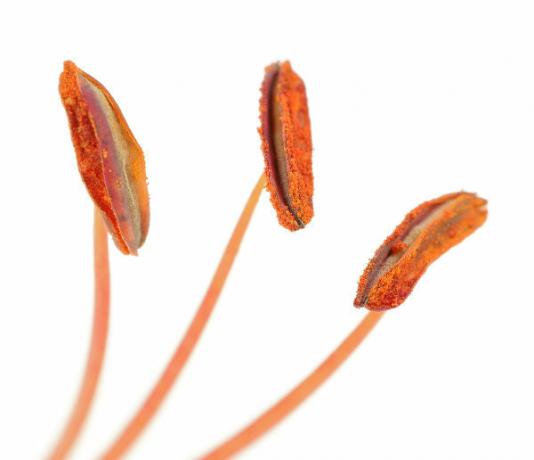Androceu is the term used to identify a set of stamens, structure of the flower that carries the pollen. The androceu is often also called male part of the flower, since this is where the pollen grains are produced (structures that have the male gametophyte in them).
Read too:pollen grain
→ stamens
Stamen is the part of the flower where the pollen grains are produced..It can be inserted in the floral receptacle (in this case it is called free stamen) or it can be attached to the petals (in this case, it is called epipetalus). The stamen is formed by two basic parts: the fillet and anther. Look the following picture:

Note the basic parts of a stamen: the fillet and anther.
Fillet: is rod where the anther attaches. The anther can join the fillet at the base, the back or the apex, receiving the name, respectively, of anther basifixa, dorsifixa and apicefixa.
-
Anther: where are the pollen bags, place where the pollen grains are produced. Anthers usually have four pollen sacs, which are arranged in two pairs. Each anther lobe (theca) contains two pollen sacs. THE
pollen grain release occurs by opening of the teak. This release can occur by the appearance of longitudinal cleft, by pores in the region of the apex of the theca or by valves.Do not stop now... There's more after the advertising ;)
Read too: Pollinators

The opening of the anther ensures the release of the pollen grain.
The stamens can be called monadelfos, diadelfos and polyadelfos. Monadelphia stamens are those that are united in a single group. Diadelphic stamens are united into two groups. Polyadelfos, in turn, are united in many groups.
→ Number of stamens in a plant
The number of stamens varies greatly from plant to plant. While some plants have only one stamen, others have a large number of these structures. Analyzing the amount of stamens and the number of petals, we can classify the flowers into:
Isostemones: same number of stamens and petals.
Oligostemones: less stamens than petals.
Polystemones: more stamens than petals.
By Ma. Vanessa Sardinha dos Santos
Would you like to reference this text in a school or academic work? Look:
SANTOS, Vanessa Sardinha dos. "What is androceu?"; Brazil School. Available in: https://brasilescola.uol.com.br/o-que-e/biologia/o-que-e-androceu.htm. Accessed on June 29, 2021.
